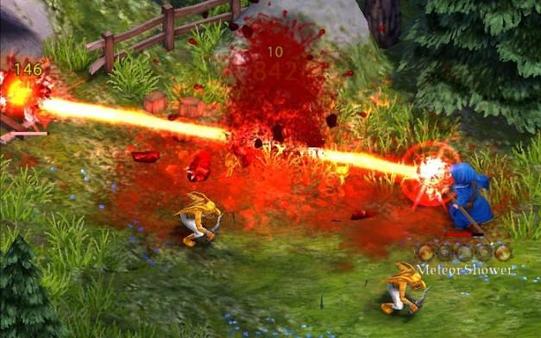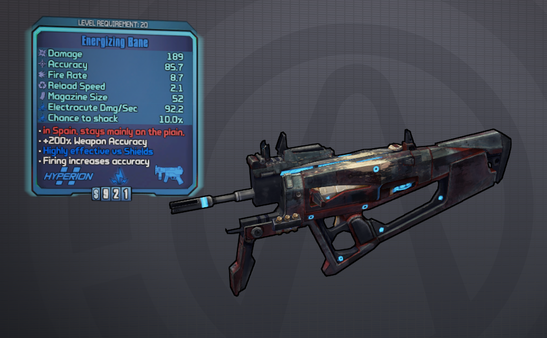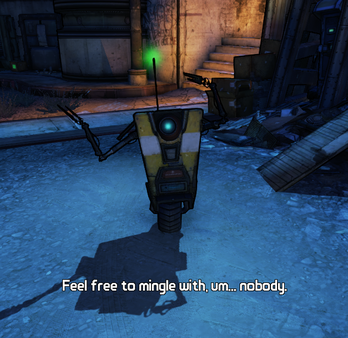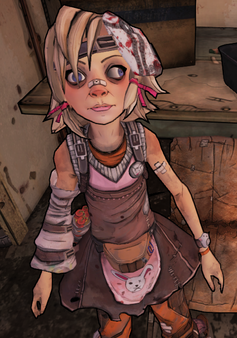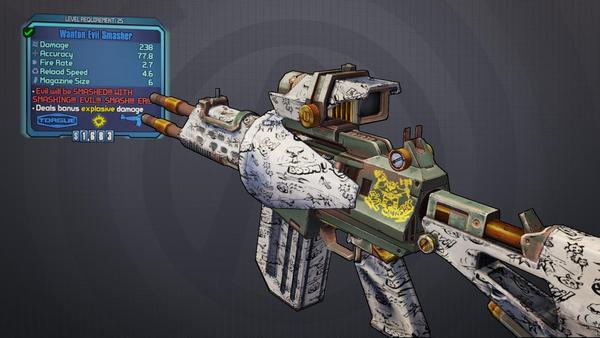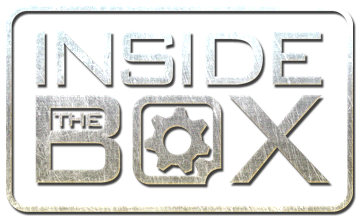
Inside the Box serves as a forum for individuals involved in the production of Gearbox Software content to share personal motives, methods, process and results. Gearbox Software projects are created by a diverse range of individuals spanning a spectrum of different backgrounds, interests, objectives and world views. The views and opinions expressed in this article are those of the author and do not necessarily reflect the official policy or position of Gearbox Software or any of its individual members outside of the author.
Hi, I’m Anthony Burch, lead writer for Borderlands 2. At this year’s GDC, I did a talk entitled “Designing Humor in Borderlands 2.” I’ve adapted the talk into a less profanity-laden Inside the Box article. Below, you’ll read about how we attempted to convey humor in Borderlands 2 through gameplay alone. You won’t learn how to write funny dialog (because I still don’t know how to do that reliably), but you’ll hopefully learn something about how we tried to convey humor through game design rather than just text-based narrative stuff.
Before I discuss how we tried to make Borderlands funny, I need to point out that Borderlands is not a comedy game.
QWOP is a comedy game. The way it turns the simple act of walking into an experience more difficult than playing Dark Souls blindfolded is inherently hilarious.
Magicka is a comedy game. If you can’t tell from the screenshot, that’s a player, that goblin is an enemy, and I believe that little cloud of red mist between the two is another player. The way you constantly and accidentally kill your friends in Magicka and suffer literally zero consequences is inherently hilarious. Both QWOP and Magicka have humor as part of their DNA.
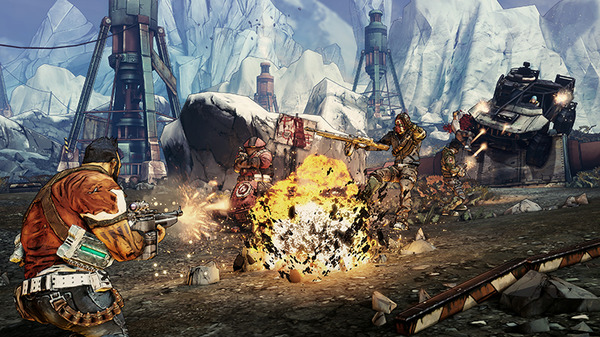
Borderlands, conversely, is a shooter. There’s nothing inherently all that hilarious about killing bazillions of dudes or grabbing lots of guns, apart from how over-the-top that sort of violence is – the gameplay loop is about empowerment, discovery, choice, and so on. Not humor. The humor is mainly relegated to the game’s narrative.
And even from a high level, we decided that we didn’t want the narrative to get really crazy and goofy anywhere along the main plot. We felt that the main story, the majority of the experience, should be a little bit more serious so that people didn’t feel the game was too silly or dorky. We used Firefly as our tonal touchstone. Characters could be funny in the main story, but the plot should still be straightfaced.
Conversely, the sidequests could be more surreal and out-there, sort of like an Adult Swim show where you can be as weird as you want so long as it gets you a laugh. So, with humor being a part of the game’s DNA rather than its central attribute, we had some constraints to work in.
Rather than designing brand new systems to make the player laugh, we had to take the existing mechanics we had – mechanics designed for shooter gameplay–and co-opt them in order to make fart jokes.
Which brings us to The Bane. Early in development, creative director Paul Hellquist and I had an idea for a quest that would basically be like an interactive version of the film Winchester 73, starring Jimmy Stewart. If you haven’t seen it, the movie is basically about this one-of-a-kind gun that keeps going from owner to owner, and every person it touches ends up dying in some ironic way because the gun is cursed or whatever.
We thought, oh man, what if the gun keeps sapping your health unless you trade it to another player on your friends list, or what if it drains XP, or what if – we came up with a bunch of really brutal, tragic curses this gun could do to you. So we talked to Matt Armstrong, who was creative director of the first Borderlands and designed all the guns, amongst other things, on Borderlands 2, and found out that our tragic gun idea wouldn’t quite be tenable. But Matt suggested that we could at least try to get a few cheap laughs.
So in Borderlands 2, there’s a quest where you track down a cursed gun known as The Bane by following the corpses of its former owners, all of whom talk about the horrible curse of The Bane. And we try to build it up as being big and scary and ominous. And you eventually find The Bane, and once you look at its stats, they’re incredible – it’s entirely likely that this is the best gun you’ve yet found in the game. But this is what happens once you equip it.
Once you equip the bane, your movement speed slows by like 70%, and the gun makes incredibly irritating noises whenever you shoot, reload, or switch weapons. And also, the annoying noises ignore your volume controls – they always play at max volume.
Without writing a single line of “funny” dialog, The Bane was an attempt to turn a piece of loot into a punchline. And because it’s a piece of loot, because it’s not a line of dialog but an actual item, the joke can actually get better depending on how the player deals with it. Since the gun is really good, maybe the player has to make a strategic decision between the usefulness of the gun and their own tolerance for irritating noises. Or maybe you’ll join somebody else’s game and start using the bane, and they’ll get so irritated that they’ll kick you the fuck out – that’s kind of a curse. That’s kind of funny.
But let’s switch gears really quickly and talk about the concept of pattern breakage, especially as it relates to humor.
If you set a pattern, you have an opportunity to make your audience laugh by breaking that pattern. For example, the old “orange you glad I didn’t say banana” knock knock joke is entirely predicated on making the audience expect you’ll say “banana” a third time, only for you to say “orange” and then make a stupid pun. Granted, “orange you glad I didn’t say banana” isn’t exactly the height of comedy, but the basic principle it works off is still a valid one. We decided to use the principle of pattern breakage, along with our most recognizable character, to come up with a quest called Claptrap’s Birthday Bash.
Claptrap is probably Borderlands’ most famous character. And in Borderlands 2, we really tried to push the idea that Claptrap, while he might be beloved by the player, is pretty much despised by everyone else. He’s got literally zero friends, and nothing he does ever goes right – he’s like Charlie Brown, basically. And when we decided we wanted to explore this aspect of Claptrap’s loneliness in a quest, we fell back on the idea of pattern breakage.
So what patterns can be found in Borderlands 2? Well, there are a lot of quests in the game. That’s a pattern. And generally, we try to teach the player that quests in our game are very active – you go out and shoot things, grab things, protect things. They can also be accomplished at your own pace – you can leave an area and come back later and the quest won’t have failed or anything. Lastly, the quests, most obviously, intend to be fun. They will show you something cool, or force you to do something challenging. Regardless of whether or not a quest succeeds in its attempt to be fun, fun is certainly something all of our quests shoot for.
Except Claptrap’s Birthday bash.
Basically, Claptrap’s just turned seven years old and he wants you to invite all of the other NPCs in town to celebrate. So you grab a bunch of invitations and hand them out to Moxxi and Marcus and Scooter, and they all say no way, I’m not going, I hate that guy. But Claptrap doesn’t know that, so you come back to him as he, blissfully ignorant, starts the party and waits for all his guests to arrive.
What follows is one of the biggest structural pattern breaks in the game. For about three minutes, you have to attend Claptrap’s lonely, awkward birthday party and there’s nothing you can do to speed it up. You just sit there while he dances around to cheesy music and blows party favors and keeps convincing himself everyone just got lost on the way to his party. This quest succeeded so much as a piece of awkward, dark comedy that some people in our forums said it was the saddest part of the game, and we kill like five of our main characters.
But if the Birthday Bash works, it’s because it goes against everything that the game has taught you to expect from a Borderlands quest: it’s NOT active, you CAN’T complete it at your own pace because it’s on a timer that resets if you leave the map, and it’s definitely NOT fun.
There’s also another, simpler quest in the game that serves as a significant pattern break. It’s called Shoot Me In the Face.
So, average Borderlands 2 quests are long, dynamic, and full of interesting gameplay. What you just saw was none of those things.
But what’s really important about this quest in terms of its pattern break is that one of the designers, Graeme Timmins, specifically suggested that we place it more than halfway into the game.The player needed time to play through a bunch of sidequests and internalize their basic structure – they needed to acclimate to the pattern before we could break it.
If we placed this quest in, say, the first zone of the game, then it wouldn’t have been funny, because players would not have realized that Shoot Me In The Face was different from all the other quests, and it also would have taught the player an incorrect lesson – basically instilling the idea that a lot of quests are going to be super-short and super-easy. It would have sent the wrong message.
Now, those two quests you just saw played pretty well with our focus testers and some of our players, but they weren’t easy. Because jokes are work.
Those two quests in were fairly hard to sell to the team, for the exact reasons that make them funny. It’s kind of hard to stand in front of an experienced designer and say, “no, it’s gonna be great – you’re going to spend hours implementing this quest I spent about thirty minutes writing, and the player is going to finish it in TWO SECONDS,” or, “yeah, the point of this quest is to make you feel REALLY AWKWARD!”
But that brings me to an important note: your team is your most important audience. The designers, not me, were the ones to actually implement all of these jokes. It was important to have them onboard because, as intelligent and creative people, they needed to feel confident in adding their own awesome style to the implementation.
For instance, there’s a whole section in the game about a character called Tiny Tina, who’s this really hyperactive and intense thirteen year old bomb-maker. And after everyone heard the dialog we’d recorded for her, you get to see all the different departments add something. Art added a bunch of really cool bunny decals everywhere. Level design put in a bunch of bombs in the level to tell the story of how Tina survives out here – they pretty much only exist to hurt you and occasionally your enemies, but they tell a story. Animation gave Tina a really funny faceplant animation when she moves to her bed. And Skyler Jermyn, the designer of Tina’s quests, sent me a bajillion requests for additional lines and cool things Tina could do in the environment, and we had an awesome monthlong back and forth discussing new things for you to do in Tina’s missions and new lines she’d need to say.
And also right here, you’ll see that her eye tracking doesn’t work and can occasionally make her go cross-eyed. But since the team understood and liked the joke of Tina being hyperactive and crazy, they decided, fuck it, that’s an awesome bug, and they kept it.
And I didn’t mention it earlier, but remember The Name Game quest? The one with Bonerfarts? See, since Bullymongs have many different kinds of variants – bullymong slingers, monglets, etcetera. Ruben Caberera, the designer who created them, had to come up with additional names for each of the Bullymong variants for every step of the quest. So Bullymong Slingers became Bonerfart Slingers, and Bullymong Pups became…
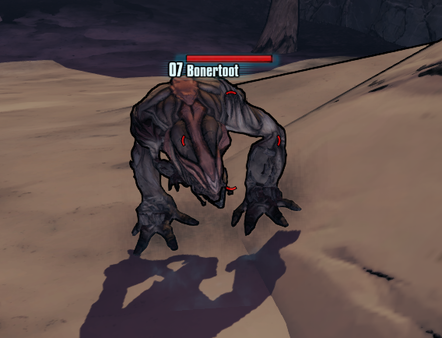
Bonertoots. Which is easily the funniest thing in the mission, and I didn’t have a frigging thing to do with it. Basically, if your co-workers find the joke funny, they’ll make it even better.
Another thing that’ll make jokes better? Multiple attempts at making them. Like I said, Jokes are work, and design is iterative, and there’s often no way to know if a joke is funny, or how to make it funny, until you implement it the first time and find out why it sucks.
Claptrap’s Birthday Bash, for example, didn’t work for a REALLY long time. You just stood around doing nothing, but there was no music and Claptrap only had a few lines, so the quest just felt buggy. You’d stand there and the timer would count down, but you’d have less of a “wow, this is awkward” feeling and more of a “is something supposed to be happening right now? Did something not trigger that was supposed to trigger?”
It wasn’t until we implemented the first set of dialog that Paul Hellquist had the idea to add a bunch of new objectives to eat cold pizza and blow into a sad party favor, and audio scrounged up some incredibly awkward and cheesy party music. Once we got a pickup session for the additional dialog required for the changes, and once all of that went in, the quest went from feeling broken and awful to being pretty good.
Similarly, if you go back to Shoot This Guy In The Face, we thought it would be the easiest quest in the WORLD to implement. I mean, you just shoot the guy, right? But what if the player says, “Naw dog, I don’t wanna?” If you shoot him anywhere BUT his face, does he die? Does that then fail the mission? Then how does he respawn so you can get the mission again?
In practice, Shoot This Guy In the Face was one of the most weirdly complex quests in the game despite its apparent simplicity. Designers Ryan Heaton and Drew Mobley had to add a bunch of optional objectives to NOT shoot the guy in areas that AREN’T his face, but since optional objectives are generally something you DO rather than something you DON’T do they had to start off checked and then UNCHECK themselves if you accidentally shoot him anywhere else, and…yeah, this mission was some bullshit. But in the end, people really liked the quest.
But I don’t want to make it sound like everything was perfect and nothing bad ever happened. Sometimes, try as you might, jokes fall flat – for various reasons.
Sometimes the joke is too ambitious for the mechanics. Paul and I had an idea for a quest chain about Dr. Tannis, an insane genius xenobiologist. The idea was that she’d send you out to collect a bunch of stuff to get ready for what she called “The Vending Machine Apocalypse,” and, her being crazy, you’d just sort of write her off as being a nutjob but do the quest anyway. Then, like three hours later, you’d find a Vending Machine just sort of sitting on top of the corpse of a skag, and Tannis would be like, “…and so it begins.”
And then even later, Tannis would say she’d tracked down the Uber-Vending Machine, the leader of the revolution to overthrow mankind, and that you were destined to defeat it in single combat, and you’d go to the slightly larger-than-average vending machine, and Mars Bringer of War would start playing, and a boss bar would appear for the vending machine and you’d whack it with your fist a few times, and she’d be like, “OH GOD IT’S CHARGING IT’S ULTIMATE ATTACK”, and it’d make this big charging-up noise and then just sort of fall over. And she’d yell, “WE’RE SAVED,” and triumphant music would start playing.
And we didn’t end up doing because of two reasons. Firstly, the idea isn’t all that funny. Secondly, when you get smart, talented people talking about an idea, the idea gets better. And the better the idea is, the harder it can be. Because while the initial idea was just to make the Vending Machine sort of sit there awkwardly, we played with the idea of making Tannis actually completely right about the impending apocalypse, and having the Vending Machine be a really fun boss fight that would drop massive grenades out of its item slot, and move around, and maybe have a jetpack, and say stuff, and so on – and we quickly found ourselves in a position where the quest would have required a LOT of work before we could find out if it was even funny or not. So we cut it.
But there was one quest we didn’t cut that didn’t quite sell its joke very well. The quest was called The Chosen One. It was inspired by the idea that merchants in the old west used to cut their cornmeal or flour with sawdust and things like that, to the point where if you bought a pound of flour only like two percent of it was actually flour and not rat turds or whatever. We thought, okay, that’s kind of shady and sad but also kind of funny – what would the Borderlands equivalent of that be?
In The Chosen One, an arms dealer named Marcus meets an egocentric, nerdy podcast host named Kai. Kai insults Marcus, so Marcus makes up a story that Kai is some mystical Chosen One, and he tells him to buy a piece of shit gun from him called the Evil Smasher. So Marcus overcharges the kid for the gun, and tells him to go out and fight evil, and since the gun is a piece of shit, Kai gets killed and Marcus doesn’t have to worry about giving him a refund.
Now, this quest was, like The Bane, intended to give the player a gun that acted as a nonverbal punchline to the entire quest. You were supposed to find Kai’s body and see The Evil Smasher that Marcus had sold him, and it was originally intended to have literally the worst stats imaginable – takes five minutes to reload, it only does one damage, etcetera.
Hopefully you’d see the gun and realize, wow – Marcus really screwed this kid over. I hoped it’d be a neat little moment of dark humor. From a comedy perspective, the gun should have been as awful as humanly possible to drive the joke home.
When it came time to make the gun, however, Matt Armstrong and I talked it over and he brought up some good counterpoints from a design perspective. Philosophically, he said, every gun in the game should be useful in some situation, no matter how rare. And not only that, but from a production perspective, it’s kind of a waste to spend time making a gun that people specifically should not use because it’s so bad. Remember that even though the Bane was annoying, it was still a really good gun.
So, we came to a compromise: the stats on the gun would be sub-average most of the time, but every time you reloaded, you would have a really low chance that the next clip would do 20 times its normal damage and give the gun an increased fire rate. The hope was that the first time you picked up the gun, you’d see that it sucks and get the joke. If you stuck with it, however, you’d realize that the gun is actually amazing in some circumstances.
In practice, though, two things happened: firstly, the stats on the gun were not great, but they were pretty subtle in their not-greatness, so nobody really got the joke. Secondly, the chance for the gun to do 20 times its damage resulted in a bug where you could get it to do like a hundred thousand times its normal damage, and increase the fire rate greatly, AND where you could transfer that damage bonus to literally any other gun in the game, including a gun with infinite ammo. One little joke caused a bug that allows you to kill any raid boss in the game in less than five seconds.
Whoops.
Looking back, I wonder if we should have picked a side rather than compromising – we should have just made the gun decent in its own way and left it at that without trying to compromise gameplay for humor’s sake.
But even when the jokes are at their best, they can still be risky. Because sometimes, humor — or at least Gearbox’s sense of humor — or at least my sense of humor — can be kind of divisive. If, say, a badass one liner isn’t as badass as you would have hoped, then it’s not really a big deal. But if a joke isn’t funny, it can sometimes seriously impact your audience’s perception of the rest of the game. For example:
“With the right joke, “bonerfart” would be hilarious, I’m sure. But this game is short on jokes — it tends to stop at crass and assume that it’s made it all the way to funny. And then does it again, and again, and again.” – David Thier, Forbes.com
The rest of Thier’s article basically says that it was really difficult for him to enjoy the actual mechanics because he kept having shitty jokes thrown in his face. Which, if you don’t find our sense of humor funny, is a completely reasonable reaction to the game.
Now, I legitimately don’t know what to do about this problem short of building a machine that will transform me into Erik Wolpaw, but I just thought I should mention that humor can be a risky proposition.
That said! When it pays off, it can pay off pretty well. For the first couple of weeks after the game’s release, many of our weirder quests got press just because they were so outside the norm. Whether we’re talking about The Bane, or the sniper rifle that calls you a bad person everytime you kill someone, or Moxxi’s submachine gun that makes you controller vibrate really, really fast, these quirky little moments got us quite a bit of online coverage just by virtue of the fact that they existed.
Our fans seemed to dig that stuff, too. Earlier, I mentioned that when we set out to write the story, we decided that the sidequests could be silly and surreal, but that the main plot had to be comparatively straight-faced. The characters could be funny, but the plot had to be more or less serious.
Internally, there was a lot of worry about the tone of the game going too silly or goofy, to the point where people would both hate the jokes themselves for feeling out-of-place in our universe, then hate the gameplay because now they didn’t feel like a quasi-serious badass in a quasi-serious badass world – they felt like a goofy cartoon character in a goofy cartoon world.
In practice, however, we found the opposite was true: many players liked the jokes and surreal stuff in the sidequests much more than they liked the more serious plot. This was a surprising and interesting thing to hear. While I think we can probably do more work to make the really dark stuff feel more in line with the more silly stuff, it’s still really good to know going forward that players are willing to put up with our weird sense of humor.
And that’s pretty much all I got. Thank for reading.
If you have any feedback on this article or what you want to see here on Inside the Box please let us know at [email protected], hit up our forums or tweet me @reverendanthony


